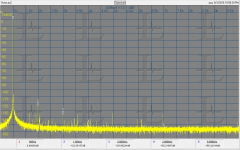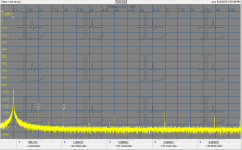@Tazzz
If you read the first post, design goal no. 1, you will see that this was indeed the intention from the start. And it does support that, preferably by using the ASIO interface.
@davada
Yes, relays can be quite fast. I use this as part of the protection method.
I think that it is better to let the analyzer SW switch the input range if this is the desired way of operating it. I could also implement it in the XMOS, but the analyzer SW should still control this, because you don't always want autoranging. So in my view it is better to let the analyzer SW control it, if needed.
With the latest XMOS firmware this control mechanism from the PC is now possible.
If you read the first post, design goal no. 1, you will see that this was indeed the intention from the start. And it does support that, preferably by using the ASIO interface.
@davada
Yes, relays can be quite fast. I use this as part of the protection method.
I think that it is better to let the analyzer SW switch the input range if this is the desired way of operating it. I could also implement it in the XMOS, but the analyzer SW should still control this, because you don't always want autoranging. So in my view it is better to let the analyzer SW control it, if needed.
With the latest XMOS firmware this control mechanism from the PC is now possible.
Hi David,
Ah, okay.
The LM3914 or LM3916 solution is elegant. They make one that is linear, the other is a log type resistor string. Also, a comparitor could be used for a custom set of switch points. You would want some hysteresis built in too. Of course, these start low, and you would have to use the dot mode to keep the other relays open. I think they have 5 switch points (drive 5 LEDs). Sounds too good to be true, maybe the resistors aren't of high enough accuracy from range to range. Only testing will show this.
Anyone have a drawer full of these things?
-Chris
Ah, okay.
The LM3914 or LM3916 solution is elegant. They make one that is linear, the other is a log type resistor string. Also, a comparitor could be used for a custom set of switch points. You would want some hysteresis built in too. Of course, these start low, and you would have to use the dot mode to keep the other relays open. I think they have 5 switch points (drive 5 LEDs). Sounds too good to be true, maybe the resistors aren't of high enough accuracy from range to range. Only testing will show this.
Anyone have a drawer full of these things?
-Chris
@Tazzz
If you read the first post, design goal no. 1, you will see that this was indeed the intention from the start. And it does support that, preferably by using the ASIO interface.
@davada
Yes, relays can be quite fast. I use this as part of the protection method.
I think that it is better to let the analyzer SW switch the input range if this is the desired way of operating it. I could also implement it in the XMOS, but the analyzer SW should still control this, because you don't always want autoranging. So in my view it is better to let the analyzer SW control it, if needed.
With the latest XMOS firmware this control mechanism from the PC is now possible.
Agreed. It's more of a protective thing anyway.
I just thought Richards idea is neat.
The best route borrows from the Boonton (et.al.) where there is a local overrange that will upscale when its overloaded but its under system control. What you don't want is the host tells the amp to go to clipping and then crash while the input is at max. If the series resistors to the input protection are small for low noise you will need fast reactions to protect them.
The lamps are between the attenuators and the input amp. The clamp diodes are after the lamp. The resistance of the lamps increases by 3X or more when they are on and normally there is no drop across them so they work really well for this stuff.
Hi Demian,
I was more wondering how they behaved dynamically. Any errors near the top of scale? As we all know, neither lamps nor Zener diodes are snap action devices.
-Chris
I was more wondering how they behaved dynamically. Any errors near the top of scale? As we all know, neither lamps nor Zener diodes are snap action devices.
-Chris
Hi Demian,
I was more wondering how they behaved dynamically. Any errors near the top of scale? As we all know, neither lamps nor Zener diodes are snap action devices.
-Chris
Lol. You hit them hard enough and they are.
Sir David,
I might have known that you've tested that setup! 🙂
-Chris
AP used it in the SYS One as well.
Better than fuses.
HP used resistors rather than lamps for the 300V safety requirement.
AK5394A performance potential
I was making some measurements with an EMU 1616M and noticed that I was getting the same distortion with different sources and then checked with my reference Victor oscillator and still ran into the -112 dB 2nd and 3rd harmonics.
This prompted me to pull out my highly tweaked demo board. The harmonics are much lower. It also gave a chance to show what grunge can come from a master clock with issues.
The difference between the two plots is adding back in an external crystal oscillator injection locking the gate oscillator on the PCB. The difference in the noise floor is dramatic. (At least if you are this deep into this stuff.)
With effort Jen's board should be pretty close and far more flexible.
I was making some measurements with an EMU 1616M and noticed that I was getting the same distortion with different sources and then checked with my reference Victor oscillator and still ran into the -112 dB 2nd and 3rd harmonics.
This prompted me to pull out my highly tweaked demo board. The harmonics are much lower. It also gave a chance to show what grunge can come from a master clock with issues.
The difference between the two plots is adding back in an external crystal oscillator injection locking the gate oscillator on the PCB. The difference in the noise floor is dramatic. (At least if you are this deep into this stuff.)
With effort Jen's board should be pretty close and far more flexible.
Attachments
Hi JensH
I'm looking for good Audio USB device which will be used for audio measurement. Is your project Audio Analyzer finished? Do you have PCB's?
I'm looking for good Audio USB device which will be used for audio measurement. Is your project Audio Analyzer finished? Do you have PCB's?
I do have some mounted PCB's, see post #528.
http://www.diyaudio.com/forums/equipment-tools/277808-diy-audio-analyzer-ak5397-ak5394a-ak4490-53.html#post4807942
I actually have a small batch of PCB's. A couple of sets are used to test alternative op-amps.
I do not plan to sell bare PCB's. I don't think it would make sense due to the large number of components, of which a lot are precision components. And at the moment I don't expect to sell mounted PCB's separately either.
I am pushing to get the mechanical design finished, to make complete products. If there is sufficient interest and they can be made at an attractive price, these will be sold as complete units.
http://www.diyaudio.com/forums/equipment-tools/277808-diy-audio-analyzer-ak5397-ak5394a-ak4490-53.html#post4807942
I actually have a small batch of PCB's. A couple of sets are used to test alternative op-amps.
I do not plan to sell bare PCB's. I don't think it would make sense due to the large number of components, of which a lot are precision components. And at the moment I don't expect to sell mounted PCB's separately either.
I am pushing to get the mechanical design finished, to make complete products. If there is sufficient interest and they can be made at an attractive price, these will be sold as complete units.
I actually have a small batch of PCB's. A couple of sets are used to test alternative op-amps.
Well, what was the decision to made the input not modular... otherwise a simple tinny PCM change would be possible as also for special high voltage (tubes) or LNA circuits and box them military like 😀
hp
- Home
- Design & Build
- Equipment & Tools
- DIY Audio Analyzer with AK5397/AK5394A and AK4490

